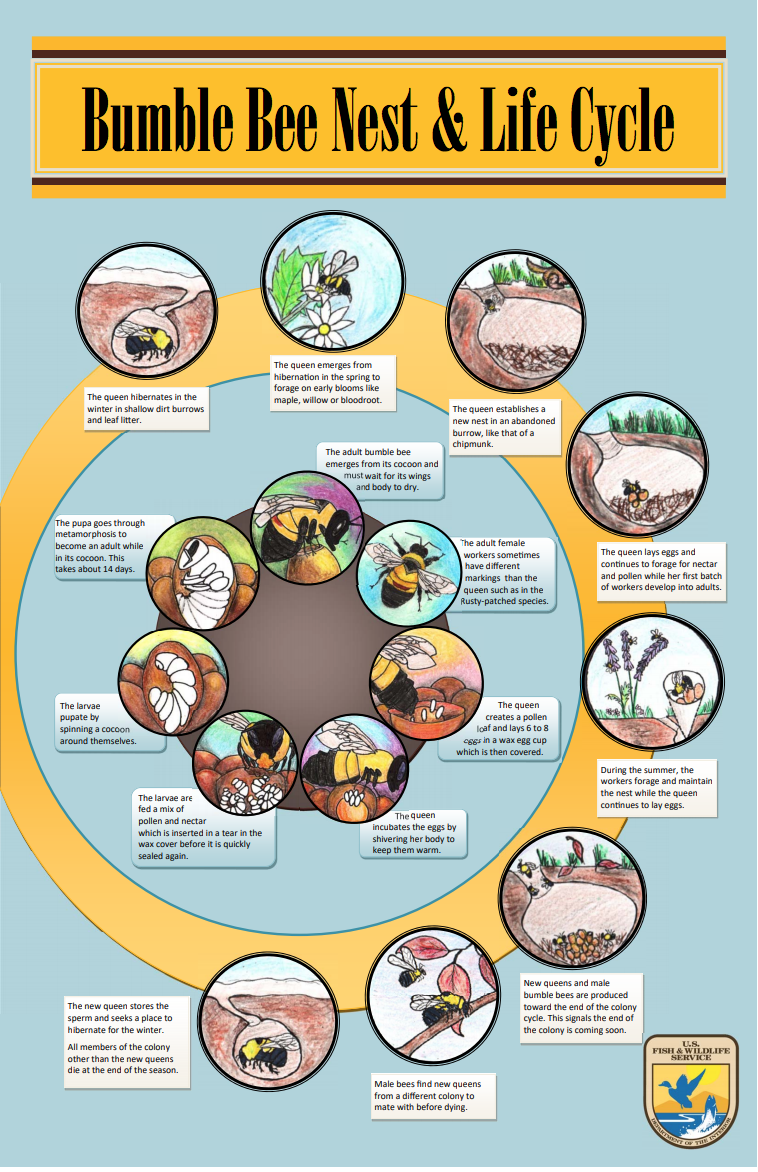All About The Rusty Patched Bumblebee
In 2017 the Rusty Patched Bumblebee was listed as an endangered species. The Rusty Patched Bumblebee was historically common from the Upper Midwest to the eastern seaboard, but in recent years it has been lost from more than three quarters of its historic range and its relative abundance has declined by ninety-five percent.
Source: US Fish and Wildlife Service. CLICK HERE to view their awesome RPB Range Map!
Colonies
Rusty Patched Bumblebees Bombus affinis, live in colonies consisting of a single queen, female workers, and males. Colony sizes of Bombus affinis are considered large compared to other bumblebees, and healthy colonies may consist of up to 1000 individual workers in a season. Queens are the largest bees in the colony, and workers are the smallest. All Rusty Patched Bumblebees have entirely black heads, but only workers and males have a rusty reddish patch centrally located on the back. (1)
Reproduction
Rusty Patched Bumblebee colonies have an annual cycle. In spring, solitary queens emerge from diapause (a form of hibernation) and find nest sites, collect nectar and pollen from flowers and begin laying eggs, which are fertilized by sperm stored since mating the previous fall. Workers hatch from these first eggs and colonies grow as workers collect food, defend the colony, and care for the young. Queens remain within the nests and continue laying eggs. In mid-July and August/ September, new queens and males also hatch from eggs. The males disperse to mate with new queens from other colonies. In fall, founding queens, workers and males die. Only new queens go into diapause over winter - and the cycle begins again in spring. (1)
Habitat
Bombus affinis has been observed and collected in a variety of habitats, including prairies, woodlands, marshes, agricultural landscapes, and residential parks and gardens (2) Bumblebees need areas that provide nectar and pollen from flowers. The nectar from flowers provides carbohydrates and the pollen provides Bombus affinis with protein. The number of queens that a colony can produce is directly related to the amount of pollen that is available.(2) Research has shown that bumblebees search for these flowers in areas that are less than one kilometer from the colonies nesting site.(2) Bombus affinis is one of the first species to emerge early in the spring and the last to go into diapause, so to meet its nutritional needs, Bombus affinis needs flowers that are in bloom throughout the colony’s long life cycle, from April through September. Although many of these flowers can be found in the prairie, many of the first flowers to emerge in spring are found near woodland habitats. (2)
Bombus affinis also need underground and abandoned rodent cavities or clumps of grasses for nesting sites, and undisturbed soil for overwintering sites for hibernating queens.
Climate
Bombus affinis live in temperate climates, and are not likely to survive prolonged periods of high temperatures (over 35° Celsius (C) (95° Fahrenheit (F). Bombus are able to fly in cool temperatures and low light levels, particularly in comparison to other bees, which can extend their daytime foraging times (2). The flowers Bombus affinis need are dependent on the proper temperature and precipitation conditions to sustain them. Extended periods of drought, for instance, may decrease the amounts and types of flowering plants in a given area because plants are affected by temperature, precipitation, and the timing of snowmelt in the spring. (2)
Why conserve Rusty Patched Bumblebees?
As pollinators, Rusty Patched Bumblebees contribute to our food security and the healthy functioning of our ecosystems. Bumblebees are keystone species in most ecosystems, necessary not only for native wildflower reproduction, but also for creating seeds and fruits that feed wildlife as diverse as songbirds and grizzly bears. Bumblebees are among the most important pollinators of crops such as blueberries, cranberries, and clover and almost the only insect pollinators of tomatoes. Bumblebees are more effective pollinators than honey bees for some crops because of their ability to “buzz pollinate.” (3) The economic value of pollination services provided by native insects (mostly bees) is estimated at $3 billion per year in the United States.(1)
Footnotes
1. RPB Fact Sheet, US Fish and Wildlife Service
2. Rusty Patched Bumble Bee (Bombus affinis) Species Status Assessment Final Report, June 2016
3. In order to release the pollen, bees that can buzz pollinate are able to grab onto the flower and move their flight muscles rapidly, causing the flower and anthers to vibrate, dislodging pollen. Pollination involving vibrations is called buzz pollination Buzz Pollination - Wikipedia





